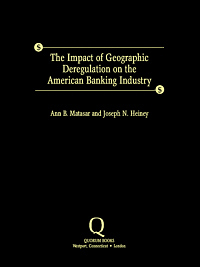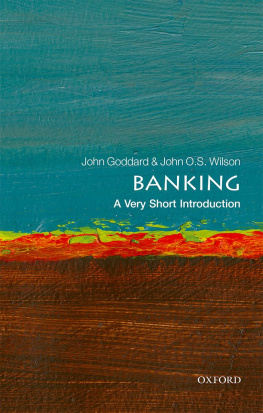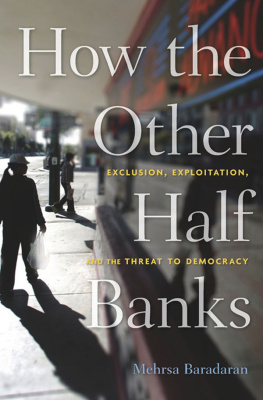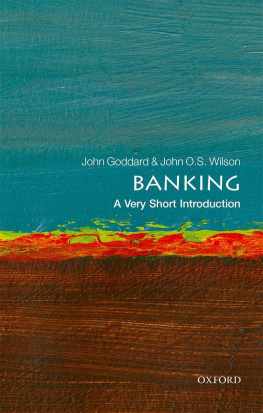Cover

| title | : | The Impact of Geographic Deregulation On the American Banking Industry |
| author | : | Matasar, Ann B.; Heiney, Joseph Nelson, |
| publisher | : | Greenwood Publishing Group |
| isbn10 | asin | : | 1567203507 |
| print isbn13 | : | 9781567203509 |
| ebook isbn13 | : | 9780313013935 |
| language | : | English |
| subject | Banks and banking--United States, Banks and banking--Deregulation--United States. |
| publication date | : | 2002 |
| lcc | : | HG2491.M33 2002eb |
| ddc | : | 332.1/0973 |
| subject | : | Banks and banking--United States, Banks and banking--Deregulation--United States. |
Page i
The Impact of Geographic Deregulation on the American Banking Industry
Page ii
This page intentionally left blank.
Page iii

The Impact of Geographic Deregulation on the American Banking Industry

Ann B. Matasar and Joseph N. Heiney

QUORUM BOOKS
Westport, Connecticut London
Page iv
Library of Congress Cataloging-in-Publication Data
Matasar, Ann B.
The impact of geographic deregulation on the American banking industry / Ann B.
Matasar and Joseph N. Heiney.
p. cm.
Includes bibliographical references and index.
ISBN 1567203507 (alk. paper)
1. Banks and BankingUnited States. 2. Banks and BankingDeregulation
United States. I. Heiney, Joseph N. II. Title.
HG2491.M33 2002
332.10973dc21 2001049180
British Library Cataloguing in Publication Data is available.
Copyright 2002 by Ann B. Matasar and Joseph N. Heiney
All rights reserved. No portion of this book may be
reproduced, by any process or technique, without the
express written consent of the publisher.
Library of Congress Catalog Card Number: 2001049180
ISBN: 1-56720-350-7
First published in 2002
Quorum Books, 88 Post Road West, Westport, CT 06881
An imprint of Greenwood Publishing Group, Inc.
www.quorumbooks.com
Printed in the United States of America

The paper used in this book complies with the
Permanent Paper Standard issued by the National
Information Standards Organization (Z39.481984).
10 9 8 7 6 5 4 3 2 1
Page v
Contents
Preface | vii |
Chapter 1 | Introduction | |
Chapter 2 | The Economic and Financial Health of Americas Banks: The Effects of Consolidation on the Private Sector | |
Chapter 3 | The Public Effects of Interstate Banking Expansion: The Impact on Bank Customers | |
Chapter 4 | The Public Effects of Interstate Banking Expansion: The Impact on Employees | |
Chapter 5 | A Microanalysis: Case Studies | |
Chapter 6 | Summary | |
Appendix 1: | Banks by Asset Size, 19901998 | |
Appendix 2: | Aggregate Condition and Income Data | |
Appendix 3: | Performance Ratios | |
Appendix 4: | Condition Ratios | |
Appendix 5: | McFadden-Pepper Act of 1927 | |
Page vi
Appendix 6: | Riegle-Neal Interstate Banking and Branching Efficiency Act of 1994 | |
Bibliography | |
Index | |
Page vii
Preface
There are three potential relationships between law and society. Ordinarily, laws mirror and defend currently accepted social values and realities. Laws also can guide a society by leading it in new directions. Finally, laws may reflect a bygone era and lag behind changing social norms.
Discomfiture with the law by one or more segments of society can occur under all of these scenarios but is, most likely, problematic and divisive when the law is out of synch with generally accepted views or practices. Ultimately, therefore, the rule of law requires an alignment of law and society. Gradual realignment results in changes that are often less noticeable and traumatic while they are in progress even though they may be far-reaching in their consequences. Rapid realignment, however, increases social anxiety and can be unsettling.
This book is the study of the institutional and systemic changes in banking in the United States as the result of the passage of the Riegle-Neal Banking and Branching Efficiency Act of 1994, the first revision of a major banking law associated with the era of the Great Depression. In the intervening years between the late 1920s or the early 1930s and the approaching end of the 20th century, the environment of banking changed dramatically on a domestic and international plane while the laws associated with banking in this country remained fixed and intransigent. During the lengthy interim, no amount of regulatory flexibility or bankers ingenuity was able to
Page viii
substitute fully for the modernization of the banking laws necessary to keep pace with the dynamic domestic and international revolution occurring in banking and financial services. Thus Riegle-Neal represents a rapid realignment of American banking law to catch up to the changes that had already taken place over a 70-year period.
Celebrated by some as the dawn of a new banking era in America, Riegle-Neal was fraught with uncertainty for individual banks and the banking industry and its constituents (e.g., stockholders, customers, and employees). By examining public data from 1994, when Riegle-Neal was enacted, until 1999, this book seeks answers to some of the uncertainties regarding the implications associated with the consolidation and resulting increased average size of American banks in the wake of a deregulatory tide.
Several challenges had to be met in dealing with the data. It was not always possible to delineate circumstances created solely by Riegle-Neal from those resulting from other systemic changes in the banking system. Inference, therefore, was required to segregate interstate experience from other banking transitions. The Gramm-Leach-Bliley Financial Services Modernization Act, which was passed in 1999 and eliminated major portions of the Glass-Steagall Act (Banking Act of 1933), will further exacerbate the difficulty in the future. In combination, however, it is certain that these two new laws forever altered American banking.
Next page












